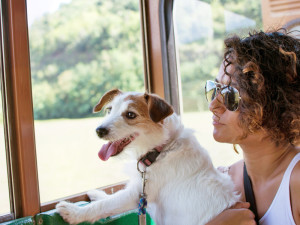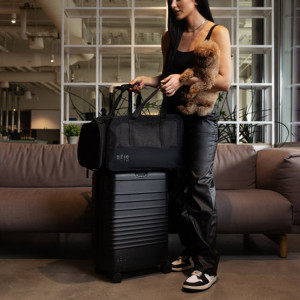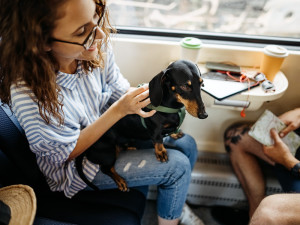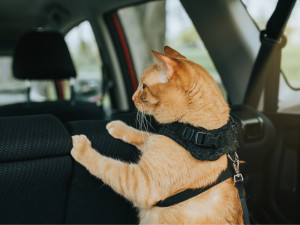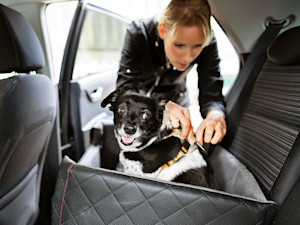Can I Hold My Dog In the Car?
You might feel like they’re safe in your arms, but that’s sadly not the case
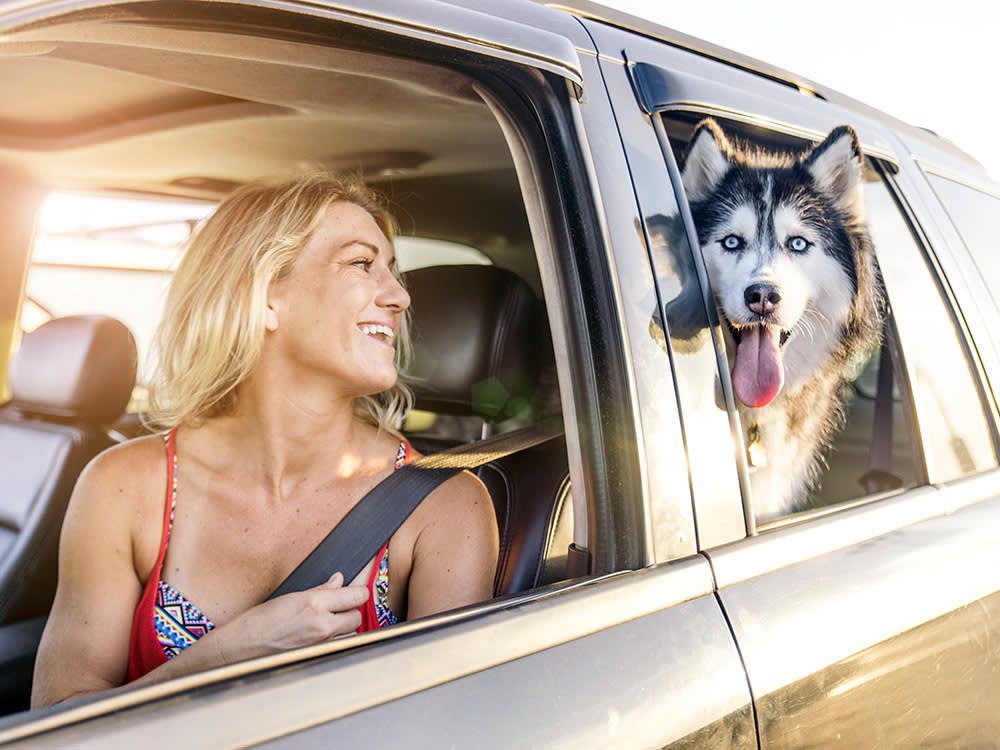
Share Article
In this article:
Can car passengers hold a dog?opens in a new tab Car travel for dogs: the lawopens in a new tab Dog restraints for the caropens in a new tab Choosing car restraintsopens in a new tab Travelling with dogs in the caropens in a new tab FAQsopens in a new tab
Is your pooch a passenger princessopens in a new tab? Perhaps they like to have their head out the window and their tongue hanging out, smelling and exploring while you’re driving. Chances are you want to cuddle with your dog even when in the car, and the dog probably wants the same thing, but is that safeopens in a new tab?
While it’s not illegal to travel with your dogopens in a new tab in a car, there are certain precautions you have to take and some good practices you should follow. Let’s look into the laws and regulations regarding having your dog in the car and holding them in your lap in the UK, so you can safely take your dog on short and long trips to the vet, the park, or the shop that sells their favourite treats.

littleKin™ is Kinship’s home just for puppy and kitten parents. Bop over to check out expert advice, new pet tools, and special deals—all curated for your newest family member.
opens in a new tabCan a passenger hold a dog in the car in the UK?
Generally, just holding a dog in the car is the least safe option, even for small breeds. A dog can break free, injuring themselves or other passengers. There is also the issue of the front passenger airbag, which may injure your dog if it gets deployed.
In the UK, passengers shouldn’t hold a dog in the caropens in a new tab. The same of course, applies to the driver, who should never hold a pet to avoid distractions and potential injuries for themselves and others. The Highway Code says that dogs travelling in a car should be ‘suitably restrained’.
“As they can jump off someone’s lap, being held by a person doesn’t qualify as ‘suitably’ restrained. The risk is too high when it comes to driver distraction and accidents,” says veterinary surgeon Dr Linda Simon.
UK laws around dogs in the car
The UK Highway Codeopens in a new tab says that you should use a suitable restraint anytime your dog (or other animal) is in the car. While the Highway Code isn’t all law (rules that contain MUST/MUST NOT are the ones that are legal requirements), the rules may be used in evidence in any court proceedings to establish liability. So, just because the Highway Code guidance around restraining dogs in the car isn’t technically law, that doesn’t mean that the fact you had an unrestrained dog in the car can’t be used against you in court, should you cause an accident.
If you drive with an unrestrained pet, it could also invalidate your car insurance policy.
The dog must be ‘suitably’ restrained
While a restraint is the best way to keep you, your dog, and others safe, the length of the harness or belt is important, too. If it’s too long, even if your dog is in the back seat, they can still cause a distraction and it will likely be a breach of the Highway Code.
We know you’d rather have your pup in your arms – and so would we – but keeping them, and everyone else safe, should be the top priority.
Your dog isn’t allowed to be in the passenger seat
Ideally, your dog shouldn’t ride shotgun with you for safety reasons, although there are precautions you can take, if necessary. Firstly, it’s a distraction to you, but more importantly, the airbags, although amazing inventions, aren’t created with dogs in mind. The force of an airbag is too strong for the average dog and enough to crush or even kill them.
Also, don’t let them hang out the window as they can injure themselves. If you want to keep a window open, pick one that’s away from your dog.
Fines if caught
If you are distracted and cause an accident, whether that’s from your unrestrained dog or other reasons, you can get charged with driving without proper control, which can equal a £1,000 fine and three points on your license.
The fines can go up to £5,000 and up to nine penalty points, depending on whether the case proceeds to court, and it can even lead to a driving ban.
What is classified as a ‘suitable restraint’?
According to the Highway Code, a suitable restraintopens in a new tab includes a seat belt harness, a pet carrier, a crate or a dog guard.
You’re also allowed to keep them in the boot (in the case of an SUV or a hatchback) if you have a headrest dog guard between the seats and the boot.
When using a seat belt harness, never clip it on your dog’s collar, but on a harness to avoid any issues if the car stops abruptly or in case of an accident, as clipping to the collar could cause neck injuries or choking.
Seat belts are the easiest option as they attach to your car’s seat belt. Bigger dogs may be more comfortable in the boot.
How to choose the right restraint for your car
You should try a few options to see what suits your dog the best. Of course, you must take into consideration the type of car journeys you will be taking your dog on. From shorter rides to the park, to longer drives to discover new places, there are options to suit all your needs.
“Some great options I recommend for my owners would include dog seat belt harnesses, as well as crates,” says Dr Simon.
“If unsure which option you’ll go for, you could have a few test runs using the seat belt option, and another few using the crate option, to see what your pet is happier with,” she adds.
Keep in mind your dog’s personality traits, size, and any fears they may have about enclosed spaces. In the latter case, a small crate will not be ideal. Test the restraint a few times before using it on the road to ensure it’s easy enough for you to open and close, while keeping your pet safe.
The belt is the easiest option, as it can be clipped directly on your dog’s harness (never the collar). Crates are the most secure choice though, since many manufacturers undergo crash tests for them, ensuring your dog’s safety in case of an accident.
How to travel in the car with your dog
Maintain good ventilation and air circulation: keep the windows slightly open or use the air conditioning.
Feed your dog a light meal two hours before you leave for your trip to prevent car sickness and ensure they take a proper walk pre-trip.
Travel essentials: always have water, food, a travel bowl, lead, poo bags, a toy or blanket they love and pet-specific wipes for your dog, as well as their Animal Health Certificateopens in a new tab (if leaving the country) with their up-to-date vaccinations and any medications if needed.
Frequent breaks: dehydration can happen quickly, so ensure you take a break every two hours to give your dog water and get some exercise and fresh air in, especially on longer journeys.
If they get anxiousopens in a new tab, take shorter trips as practice so you can slowly train them and if that does not help, you can look for any vet-approved calming chews or sprays. From personal experience, calming music and even guided meditations can help!
Never leave your dog in a hot car as the temperature rises quickly due to the sun’s reflection, and air does not circulate.
Final thoughts: passengers are not suitable restraints
As much as we wish we could hold our dogs during car rides, passengers are not suitable restraints. You may think you are holding them well enough, but keeping in mind the worst case scenarios is paramount.
Frequently asked questions about dogs in cars
Is it illegal to have an unrestrained dog in a car?
Whilst not technically illegal, the Highway Code says you shouldn’t have an unrestrained dog in your car. Failing to comply can result in penalties under careless driving or dangerous driving laws. Driving with an unrestrained dog could also invalidate your insurance policy.
Can dogs sit in the front seat?
Dogs can sit in the front seat as long as they have a restraint, although it’s not a great option because air bags are not designed with dogs in mind. If they must sit in the front seat, it is recommended that you push the seat back as far as possible and deactivate the passenger airbag.
Can a dog sit on a passenger’s lap in the UK?
Dogs shouldn’t sit on a passenger’s lap, unless also secured by a suitable belt or harness.
What are the new rules for dogs in cars in the UK?
The rules in the UK haven’t changed recently and can be found under rule 57 of the Highway Code. Updates in the code took place in 2021 regarding aspects of road safety, but the rule regarding pets while driving wasn’t altered.
Is it law for you to restrain a dog in a car in the UK?
The Highway Code isn’t the law when it comes to pets travelling in your car, but many of its rules reflect the law. For example, if you get into an accident while being distracted by your dog, you will get fined.
Resources
United Kingdom, Department for Transport. The Highway Code. Gov.uk, www.gov.uk/browse/driving/highway-code-road-safetyopens in a new tab.
www.gov.uk. (n.d.). Introduction - The Highway Code - Guidance - GOV.UK. [online] Available at: https://www.gov.uk/guidance/the-highway-code/introduction.opens in a new tab

Fani Mari
Fani is a freelance journalist, copywriter and content creator from Greece and a former Londoner. She has written for various publications including Condé Nast Traveller, Allure, Glamour and Refinery29. When she’s not quizzing dermatologists on the next it-ingredient or filming makeup videos, you can find her binge-watching shows, making candles and taking long walks in nature. She lives in Athens, Greece with her boyfriend and their dog, Joey, who obviously doesn’t share food.
Related articles
![Dog running on the beach]() opens in a new tab
opens in a new tabCan I Take My Anxious Dog On Holiday?
Think a holiday with your nervous pup is off-limits? You just need to make a few adjustments. Here’s how to have a dreamy trip that you and your anxious dog can enjoy
- opens in a new tab
How Can I Get a Pet Passport in the UK?
Don’t start packing those treats just yet...
![A woman standing next to a suitcase with a dog carrier on top while holding her dog.]() opens in a new tab
opens in a new tabThe Best Dog Carriers For Planes, Trains and Automobiles
Whether you’re driving across the UK or flying internationally, your pup can comfortably tag along
![]() opens in a new tab
opens in a new tabAll Aboard! How To Take Your Dog On A Train Journey
Heading on a UK break? Here’s how to help your pup (and you) survive that stressful train journey
![Cat standing up in the back of a car]() opens in a new tab
opens in a new tabHow to Travel With a Cat (Without a Scratch)
Everything you need to bring your cat home for Christmas, including calming products and a portable litter box
- opens in a new tab
Why Do Dogs Get Car Sick?
Car sickness isn’t just a human problem – it’s also common in dogs. But what causes it, and how can we help them feel better?
![Dog in a car seat being strapped into the seat belt by their harness]() opens in a new tab
opens in a new tabHow to Keep Your Dog Safe In a Car According to Experts (and the Law)
Including how to stop them jumping out the window whilst you’re driving...

